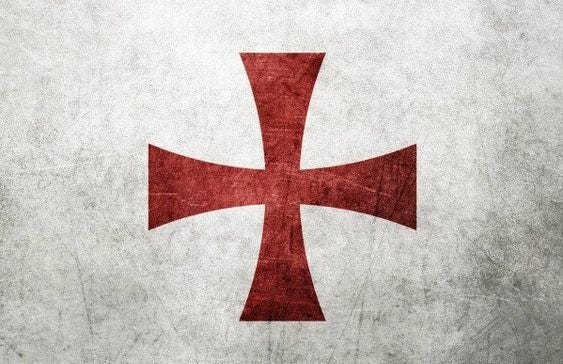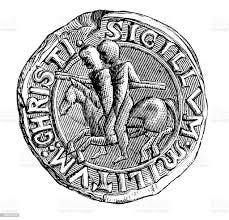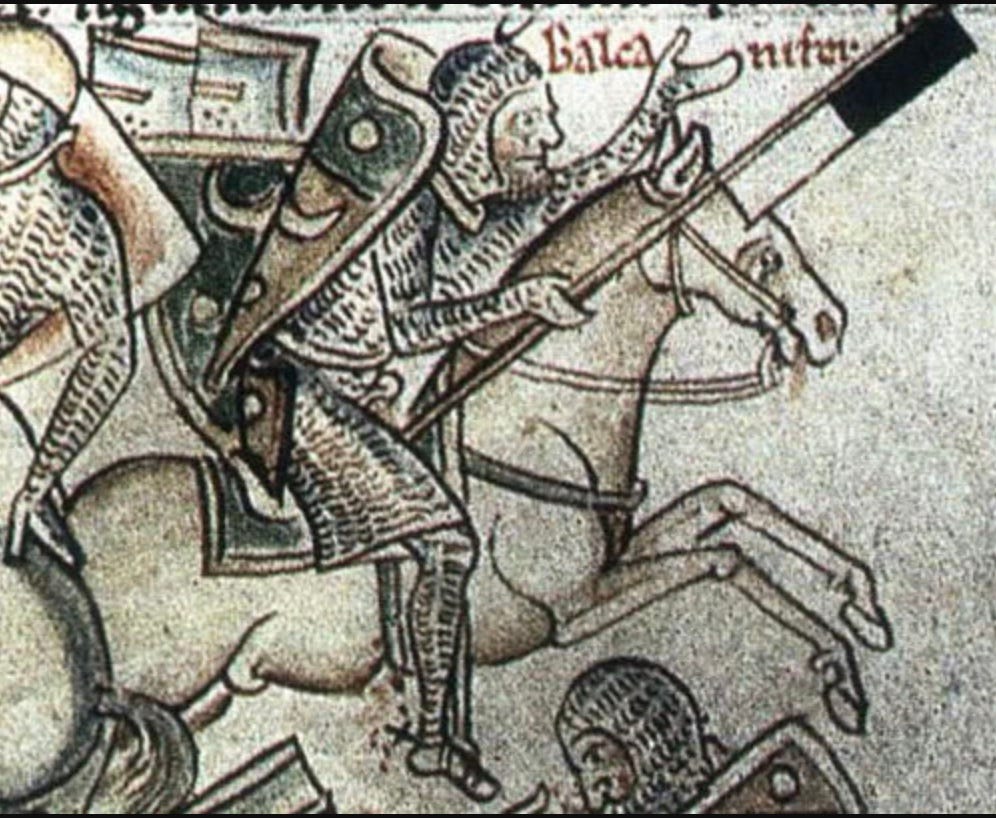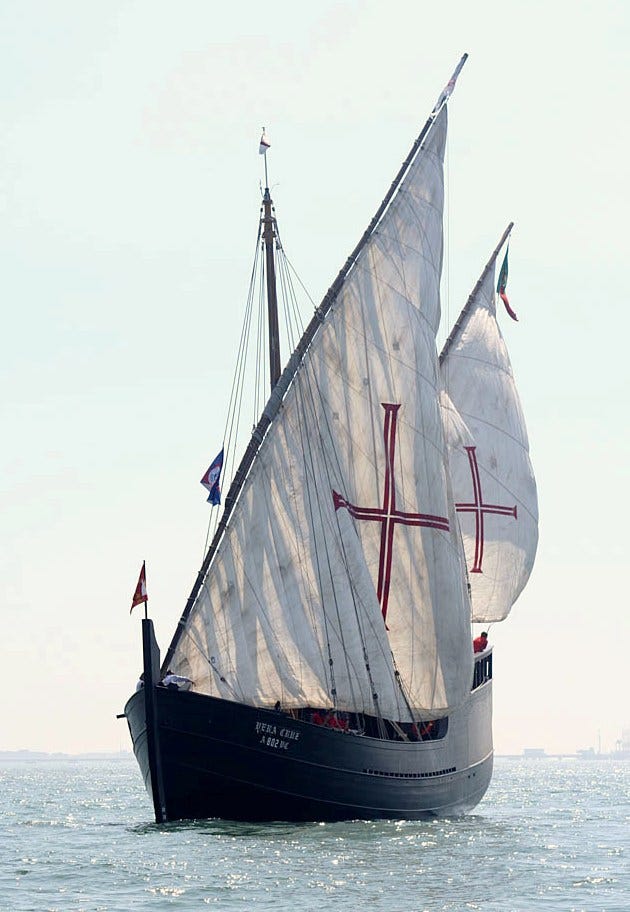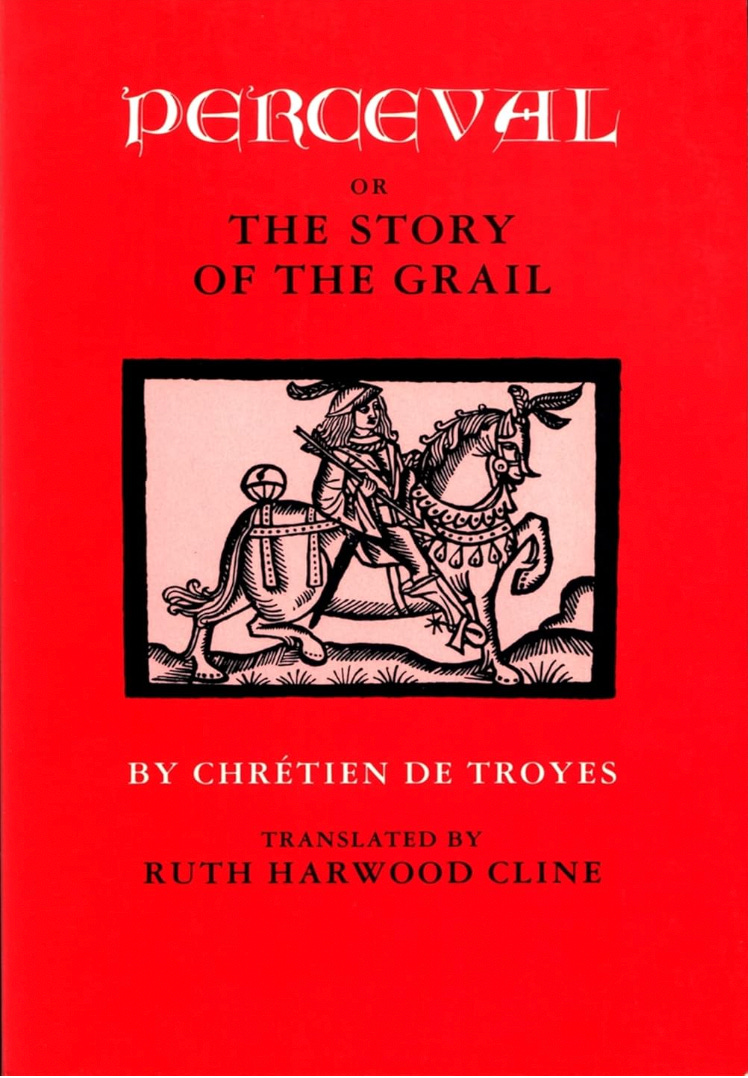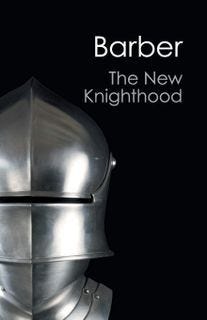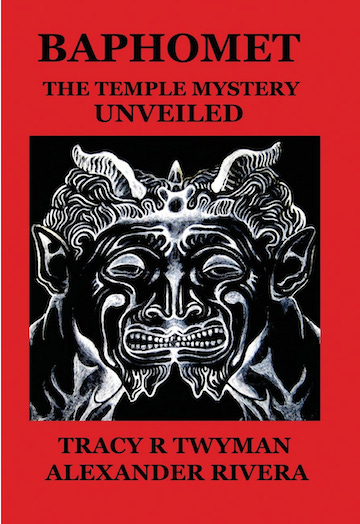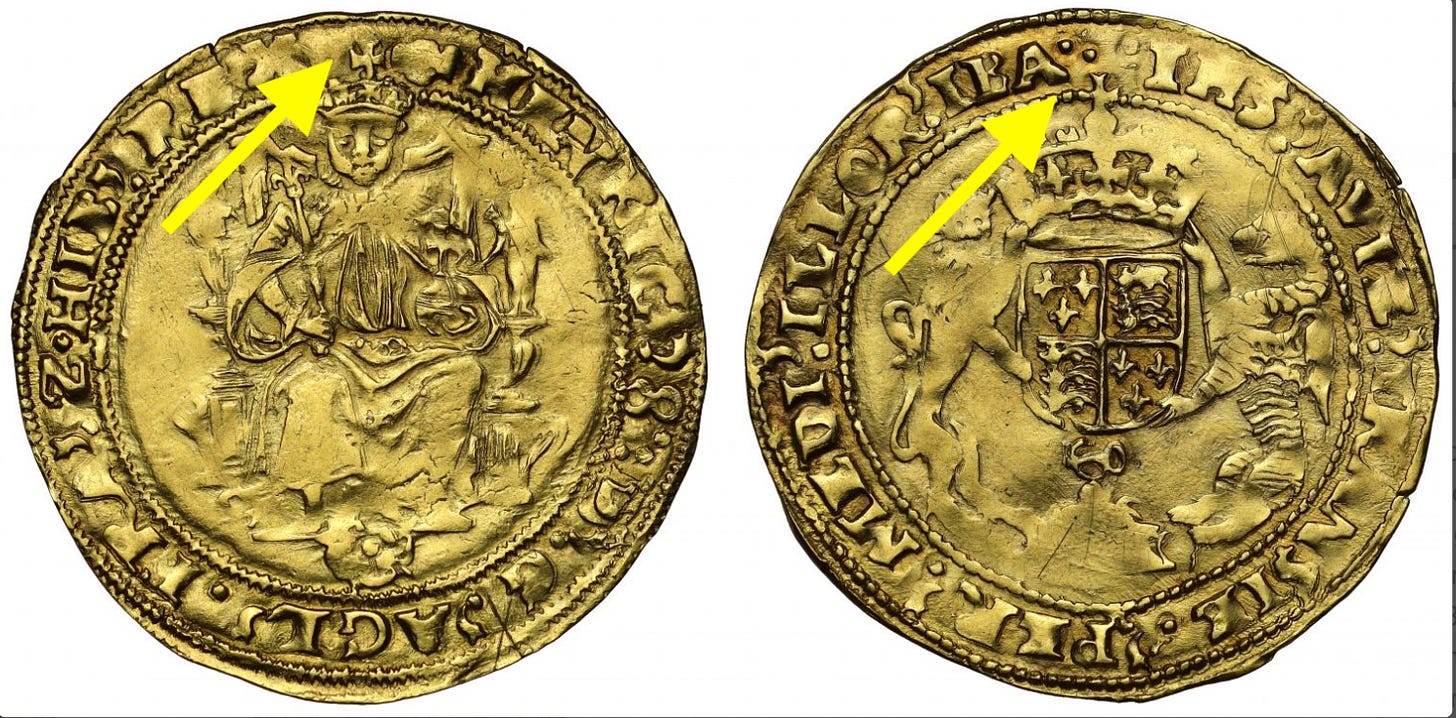How (And Why) The Knights Templar Became The Freemasons
War and International Banking Got Married At The Crusades
The Crusades, a two centuries-long disaster of immense proportion, were made exponentially worse by TWO CRITICAL ERRORS. The first was the creation of the powerful sword-wielding Knights Templar, the horse-mounted fighting monks who became the world’s first international bankers. It was the first marriage of international banking and war. The second error was the public immolation of the Templars in a massive fire just outside of Paris, within sight of Our Lady, the Cathedral of Notre Dame. The Templars had failed miserably to capture the Holy Land and then failed again to defend themselves against His Holiness Pope Clement V and King Philip IV of France. The Knights Templar did succeed however, full well with the deadly sins of Pride, Greed, Wrath, Gluttony, Envy and Lust. As for the seventh, no one has ever accused the Templars of Sloth.
This is a companion essay to a series of pieces, soon to be a book, on Sir Francis Bacon and the origins of Scientism and the British Empire. For the first essays in this series go here, here and here. For an introduction to the life and times of Sir Francis Bacon, go here. Occult Freemasonry, a key component of the British Empire, announced itself to the world on St. John’s Day, the summer solstice of 1717, in London, already fully formed, an outfit soon to influence world history as the foundational palimpsest of globalism, for starters. Where had Freemasonry come from and how were they connected to the ill-fated Templars? This essay will focus on that one aspect of early (and current) Freemasonry: rumors that the Knights Templar had morphed into the Masons, rumors rife since just after Freemasonry went public in 1717. As a Francis Bacon researcher I intend to provident the specific evidence detailing the origin of Freemasonry to be a part of Bacon’s vast and unmatched human legacy. The Templars are important not just because of the rumors but because of the unique symbolism common to the Templars, Freemasonry and to Bacon’s writing: that symbol being the ancient Temple of Solomon in Israel. The Temple Of Solomon’s remains at Temple Mount are where the Templars made their home during the Crusades and from where they took their full name “The Poor Knights Of Christ And The Temple Of Solomon”. The building of Solomon’s Temple is central to Freemasonry’s death and rebirth 3rd-degree initiation ritual involving a legendary Hiram Abiff, the architect of the Temple. The symbol is seen as well in Francis Bacon’s own philosophical writings, especially in his prophesy of a technocratic science-fueled world in the fable “New Atlantis”, which contains multiple references to a "Salomon’s House”, wherein all learning is pursued
In “ Born In Blood”, the 1989 book on Freemasonry, author John Robinson states: “many more clues to the existence and activities of Secret Masonry will surely surface, if only a few students of British history can be encouraged to have one mental band tuned to the wavelength of the Masonic connection”. More clues to the “existence and activities of Secret Masonry” have indeed been found, surprisingly or not, in the plays of William Shakespeare, as attested to by Freemasons themselves. The plays of The Bard® are steeped in Secret Masonry, and just like Edgar Allan Poe’s “Purloined Letter”, they are hidden in plain sight, on stage even, at the very origin of the British Empire.
The following is a brief history of The Templars. For the wealth of evidence I have compiled showing that the Templars became the Freemasons please go to “Cut To The Chase” section below.
Burning The Warrior Monks, 1312
The Tale Of The Templars: Birth, Death and Rebirth
The Knights Templar were a Roman Catholic order of “warrior monks” created by the Vatican, along with their primary backer the French Cistercian Order’s esteemed abbot Bernard of Clairvaux. The ‘Templars’ were to be devout, abstemious and prayerful monks as well as highly trained fighters, mounted and armed, ready to do violence at any moment: a curious pairing indeed. Curiouser still, while pledged to poverty, the monks grew wealthier than kings. Perhaps the page with “the love of money is the root of all evil” was missing from their Bible. The warrior-monks were pledged to chastity as well, with one of their many rules stating “we believe it to be dangerous to look too much upon the countenance of women”. They fared with their vow of chastity as well as they did with their vow of poverty, and according to sworn testimony, (often but not always under duress or torture) they countenanced and even prescribed sex between the brothers if requested for by another brother, to avoid the sin of being with a woman. As for obedience, the order answered only to the far-away Pope, who was always quite busy on a normal day. The warrior-monks wore white tunics and white robes with the ‘splayed’ red cross attached, over chainmail armor.
They were formed in the year 1119, ostensibly for the purpose of protecting Christian pilgrims traveling from Europe to Jerusalem as well as to other sites in the Holy Land linked to the life of Jesus Christ. The Templars were heavily involved in all of the Crusades, and were formed soon after the First Crusade captured Jerusalem in 1099. They grew rich because of large grants of land donated by nobility from all over Europe, the most by far in France, but there were very many in England as well, the profits from which were meant to be used by the Templars in their ongoing battles (which included the building of many castles) against various Muslim groups in Egypt, Syria, Lebanon and Palestine. Fun fact: the Templars had a castle in Gaza, and a fortress in Acre, where their brutal and grim last stand in the Holy Land took place, a city that exists in Israel to this day.
The Templars grew influential and politically powerful not just in the Holy Land, but all the way from Scotland to Cyprus, and from Poland Portugal. They were not taxed nor tithed, but often served as tax and tithe collectors in whichever kingdom they lived. They were great soldiers but far superior as businessmen, becoming the world’s first international bankers, loaning large sums of money to royalty and nobility, able to protect and move large sums of money around. Their true success was in banking but also in shipping, carrying men, wool, wine, and silver from their European estates to fund the crusading efforts that reinforced their banking role. They engaged in piracy against the Muslim navies, so strong in ships that they broke any real need for chartered help from the Italian city-states of Venice or Genoa.
Nobility was a prerequisite to being an elite fighting Knight, yet they had many grades of members to support the noble horse mounted knights from Associates and Sergeants (non-noble fighters) to Chaplains (priests) and laborers.
Widely regarded as vain, self serving and difficult, evidenced by the many surviving chronicles from the era such as those by William of Tyre and Matthew Paris, they made some disastrous tactical errors based on foolhardy bravado or hunger for booty, leading to bloody massacres on the battlefield, often refusing to coordinate with other Christian fighting groups. Eyewitnesses did report that they comported themselves courageously in battle over almost two centuries of their presence in Palestine, winning battles as well. They were occasionally in violent in dispute with other Christian groups such as the Teutonic Knights, the Knights Hospitaller or the Frankish kings and their troops. They lived close by the Assassins, the legendary antinomian Muslims of Persia, Syria and Palestine, sharing a common enemy in Saladin. Eventually losing everything they were finally run out of the Holy Land after a long and horrifying siege at Acre, an ancient Phoenician city, another possible Gnostic wellspring. The remaining Templars returned to Europe to manage their vast holdings, their martial exploits ended, although they hoped for another crusade and managed to hold onto Cyprus for a while longer. Rumors began to circulate in France that they had absorbed a heretical Gnostic antinomian philosophy, possibly from the Assassins or the Cathars. Rumors of homosexuality and secret initiations that involved spitting on the cross spread. Nobody seems to have liked them much for their aura of untouchable superiority, a known trait of Gnostics. King Phillip IV of France, who owed the Templars a lot of money, had spies infiltrate the Templars, who then gave testimony of Templar heresy. Philip hatched a plan to do them in, and with Pope Clement V’s tacit approval (or not, it’s debated) thousands of Templars were arrested on the same day, Friday the 13th, October 1307. Imprisoned and tortured, many confessed (though some confessed without torture) to secret sex-tinged initiations, spitting on the cross, and the worshipping of an idol called Baphomet. Nobody outside the order came to their defense. A supposed massive pile of gold and silver in the Templar’s Paris stronghold was never found, and their fleet of ships disappeared. It seems a few Templars had been tipped off.
France is where almost all the torture occurred, some of it brutal, even fatal. King Phillip burned fifty-four of the Templars for recanting their confessions before a crowd in a field outside of Paris, after which the Pope dissolved the order. Eventually the last grandmaster, Jaques de Maloy, was torched on March 18, 1314, again within view of Notre Dame Cathedral, in an area called the Island Of The Jews, strangely enough. The terrible saga of the Templars officially came to its shocking conclusion. (I couldn’t help but wonder if the recent burning of Notre Dame was an act of revenge). Their massive land holdings and many business activities were taken over by various crowns or given to the Knights Hospitaller or Teutonic Knights, similar orders but without the banking, and with the addition of running hospitals for pilgrims. The Hospitallers had been formed before the Templars.
Rebirth: Templars Fuel The Portuguese Empire
The Templar story was far from over. In Portugal the Templars simply changed their name and carried on as the Order Of Christ. This newly-named order soon played a large role in the creation of the first ever global empire, the Portuguese Empire, because it was based on shipping. Vasco de Gama was a member of Order of Christ. Portugal and England as soon as 1373 formed an alliance, the Anglo-Portuguese Treaty, the oldest still-active diplomatic pact, renewed over centuries (e.g., 1386, 1643, 1815). In Germany the Templars simply merged with the Teutonic Knights. In England almost all of the Templars escaped capture, as their round up was delayed by over three months. Those who did get caught were allowed to join the Knights Hospitaller or a monastery. In Spain only a few Templars were arrested. In Scotland, when the Pope sent out an edict demanding the arrest of every Templar, the Scottish king, Robert the Bruce, previously excommunicated, ignored the Pope’s request. It was rumored that many Templars both English and French fled to Scotland. There is some archeological evidence showing this migration. As we now know Freemasonry originated in Scotland. There is a great story of on-the-lam Templars coming forth from hiding to engage in battle on the side of the Scots and Robert the Bruce a couple years after dissolution, in the epic battle at Bannockburn, leading to victory against the English and to Scottish independence, which, based on eyewitness accounts, is to me quite credible. There are today 15 active Masonic lodges in Stirling Scotland nearby Bannockburn.
In any case, the Templars survived all over Europe, even as the order itself was finished. Their cross-town rivals the Hospitallers survived as an order, now named the Knights of Malta, and are today a landless sovereign entity with passports and a headquarters near the Vatican in Rome.
The Gnostic Templars?
It has also long been thought, backed by at least a bit of compelling evidence, that the Templars came back from the Middle East charged with a Gnostic belief system. The Middle East is where Gnosticism originated and this theory is certainly plausible, and provides at least one source for the Gnostic intensity embedded in Bacon’s creation of modern Science, Shakespeare, and Freemasonry. The Assassins were a powerful group of renegade antinomian Shiite Muslims, labeled Gnostic by some historians, that the Templars encountered very early on during their misadventures in the Holy Land. There is great suspicion that Richard the Lionheart (King Richard I) hired the Assassins to kill his Christian rival, the King of Jerusalem, Conrad Monteferrat. King Richard had to make his way back to Europe disguised as a Templar. He was captured by the Holy Roman Emperor Henry VI, who ransomed King Richard to the English for 100,000 pounds of silver. Well played, Henry. Eleanor of Aquitaine, Richard’s mother, raised the ransom from nobles, churches and sheep herders. The King’s reputation as a hero of the Crusades overshadowed lingering suspicion of his involvement in the murder of Monteferrat.
The Knights Templar Find Ark Of The Covenant!!
Secrets Of Alchemy!! Bloodline Of Christ!! Flat Earth/No Virus!!
The Beatles Didn’t Play Instruments!! Paul Was Killed. And Replaced!!
JFK Faked His Death!!!
Much shite, legend and rubbish has since been written about the Templars ever since their ignominious fall. Wild claims have reached bizarre proportions, prefiguring the fringes of today’s conspiracy landscape, gripping millions of imaginations while clearly being much ado about nothing. Here’s a sample: the Templars found the Ark Of The Covenant, a story again just in the news, as CIA documents recently made public claim it was found via remote viewing! But the Templars already found it because they did extensive excavations at their headquarters on the Temple Mount during the Crusades. Excavations that no one ever reported and for which no sign of has ever been found. Undeterred by lack of evidence, the rumors expand: the Templars discovered secrets of alchemy, magic and lost technology in Egypt and elsewhere, making them a great, hidden power guarding secrets of immense proportions, prepared to rebuild civilization of needed! Claims are made that the Templars hid the Ark of The Covenant somewhere in America, including even ARKansas. These “Templars” have a current living Grandmaster who makes claims of knowledge about these secrets, and he explicitly labels his group, as well as the original Templars, as Gnostic. He’s all over YouTube and podcast-land, and by all appearances is a high ranking Freemason. For a taste of his ‘knowledge’ go here: (Knights Templar Grandmaster Spills The Beans!)
The biggest splash among the resurgence of Templar-mania is the hugely popular Dan Brown book and movie The Da Vinci Code. Brown stole the plot line of his book from Baigent and Leigh’s famous Holy Blood, Holy Grail (a book largely based on 'ancient' documents about a fake ‘Priory of Sion’ that were exposed as hoax. The book still sells) wherein the Templars get lumped in with Grail legends, the Grail being the cup of the Last Supper brought by Joesph of Arimethea to Europe. These and other legends portray the Templars as a misunderstood highly spiritual organization with deep secrets of history and of the human soul, tied to a literal bloodline of Jesus Christ, because his wife Mary Magdalene came to France, established the Merovingian dynasty with Jesus’ babies and worshiped a Black Madonna, as well as hiding yet another grail that had collected Christ’s blood as he died on the cross. This popular 20th century Grail legend semi-propaganda as entertainment by Brown et. al. was born from 13th c. entertainment hiding propaganda about the Knights, the most spectacular being the Perlesvaus, from an anonymous author from Glastonbury England, "which unlike the Grail stories of Chrétien’s chivalry or Malory’s romance, revels in gore—heads roll, bodies burn, and Perceval’s vengeance is relentless. Perlesvaus follows Perceval (here “Perlesvaus”), Gawain, and Lancelot in a quest for the Holy Grail, but it’s darker than other Arthurian tales, apocalyptic with mystical undertones, mirroring Templar militancy. The Grail isn’t just a prize but a divine force, appearing with angels or bleeding hosts, demanding purity. Visions (e.g., a child in a tree, a crucified knight) evoke apocalyptic Christianity. Scholars like Jessie Weston (From Ritual to Romance, 1920) note Templar parallels—Perceval’s white shield with a red cross, his defense of the “New Law,” and the Grail’s guardians resemble a militant order. The text’s monkish tone suggests Templar or Cistercian influence (Bernard of Clairvaux, Templar patron, looms large). It’s read as a spiritual journey—Perlesvaus as Christ’s knight, the Grail as salvation—yet its ambiguity invites esoteric interpretation, possibly Gnostic." Serving to make those brave Knights look good, the Knights who were diligently and bravely fighting evil while spreading the love. No mention of any extensive banking activities in Perlesvaux. Some entertainment as propaganda anyone? It would prove to be a keeper soon born again in Shakespeare.
The history of Templar lore in the 19th century saw much to dislike about the Templars, especially in the popular novels by Freemason Sir Water Scott, Ivanhoe and The Talisman, wherein the Templars play nasty villains. “All publicity is good publicity”?
There’s a spate of new scholarly books by university trained authors retelling the Templar story using primary documents from the 200-year Templar history that squash the most absurd claims, but at the same time down-play any of the heretical occult excess the Templars were accused of during their secret initiations, about which testimony was repeatedly heard of initiates being required to spit on the cross, worship Baphomet and engage in homosexual acts. Most of this shocking testimony was made under duress or torture. But not all of it. These new books, or some of them, almost seem designed to rehabilitate and clear the Templars of any wrongdoing, they are so sanitized. The writers are skeptical even of reports from famous contemporary chroniclers of the day like William of Tyre and the monk Mathew Paris of the Benedictine Abbey of St. Alban’s, (Francis Bacon’s hometown btw) who wrote about the Templars in his famous 1200’s era Chronicles saying: “In their arrogance, they treated other Christians with disdain, believing themselves above the law”. Among the many recent pro-Templar works by mainstream scholars are Malcom Barber’s The Trial of the Templars and The New Knighthood: A History of the Order of the Temple. The Knights Templar in Britain, by Evelyn Lord is well known and well done. The Knights Templars and Their Sources is a scholarly compendium from Routledge of essays from various scholars that came out in 2017.
The most spectacular news and spur for more research was the discovery by Barbara Frale, an Italian paleographer at the Vatican Secret Archives, of an authentic copy of the Chinon Parchment in September 2001. Her book, titled "The Templars: The Secret History Revealed," details her discovery of the parchment in the Vatican Secret Archives, the news of which was released to the news media almost to the day of the 700th anniversary of the Friday the 13th clampdown on the Templars. The Chinon Parchment was found to absolve the last Grand Master, Jacques de Molay, and other Templar leaders from charges of heresy brought against them by the Medieval Inquisition. This news made headlines around the world. “Templars Not Guilty!” Yes, they were absolved, but because they had confessed. That’s true Christianity, confess and be saved. Their confessions came without torture, they said, and they had confessed to some rather ugly practices, actually confirming many of the suspicions that Barber and the others strive to undercut. There are quite a few of these new pro-Templar books. Everyone agrees that King Philip IV had some ulterior motives in his attack on the Knights.
Offsetting these pro-Templar scholars is Tracy Twyman’s recent heavily anti-Templar, heavily occult-themed Baphomet, a real hair-raising scholarly read, going perhaps too far in the other direction. Her co-author claims to be a Gnostic. This book deserves more attention than I can give it right now. Using Hammer-Purgstall as a major source (see below)
Both Dan Brown and Baigent and Liegh’s books sold millions and millions of copies and continue to sell. Both inflate the legacy of the Templars and simultaneously set up disbelief regarding any serious claims such as I’m making regarding the actual story of Templar survival, as it can appear almost ludicrous to even discuss the Templars what with all the muddied water of extreme claims made for them. But the Templars are grounded in one hell of a story and we humans live not by bread alone but by bread and stories alone. Whoever tells the best story wins. Another famous book, Foucalt’s Pendulum by Umberto Eco, mocks Holy Blood, Holy Grail and all the absurd level interest in the Templars. The plot of Eco’s book is that three Milanese editors—Casaubon, Belbo, and Diotallevi— craft a fake conspiracy linking the Knights Templar, Rosicrucians, and other esoteric groups to a cosmic “Plan.” Their fiction spirals into real danger when occultists believe it. The Da Vinci Code followed Eco's popular satire 15 or so years later. How many really believe it, those Templars guarding the true bloodline of Christ?
Baigent was a high ranking Freemason by the way, and also novelist. But hey, let’s not go there. Umberto Eco never commented on either of the books, the half true, half lie that inspired his satire (Holy Blood Holy Grail) and the other one fictional take off that he predicted (Da Vinci Code).
“It is clear that the selective use of the sources, manipulation of the text, and the suggestion of hidden meanings and deliberate omissions, have allowed speculative writers to create an alternative foundation account for the Templars”
John Walker “The Templars And Their Sources”
It’s quite difficult to prove anything that happened 700 years ago as a truth, if it’s not generally accepted as fact already, especially if it was a truth meant to be hidden. I will provide what I believe to be overwhelming, though circumstantial, evidence that the Templars became the Freemasons. At this point it’s hard to say what actual proof there could be that was not circumstantial. In an American courtroom, circumstantial evidence is admissible and plays a significant role in both criminal and civil cases. Unlike direct evidence, which explicitly proves a fact (e.g., an eyewitness seeing a crime) circumstantial evidence indirectly suggests a fact through inference, requiring the judge or jury to connect the dots.
Following is the circumstantial evidence for the conversion of the Knights Templar to the Freemasons. The great English historian of Gnosticism Charles William King states:
“…the downfall of the [Knights] Templars…With their scandal and their fate, is coupled the most singular phenomenon of modern times--the preservation by their professed descendants, the Freemasons, of so much symbolism that appears to be indisputably Gnostic in its origin.”
~Charles William King The Gnostics and Their Remains (1885)
CUT TO THE CHASE
The Similarity Of Freemasonry To The Knights Templar
TEMPLARS: initiations were at night in total secrecy with an armed guard outside the door
FREEMASONS: initiations at night in total secrecy with an armed guard outside the door (called a “Tyler”)
TEMPLARS: called each other ‘Brother’
FREEMASONS: call each other ‘Brother’
Bro, this may be common now but back in the day it was not. Article 387 of the Temple rules states, “No one who is not a brother of the Temple may be present at the chapter meeting”. Freemasons famously refer to to themselves as ‘brothers’ and as ‘the brethren’.
TEMPLARS: excluded women
FREEMASONS: exclude women.
Freemasonry, as part of its genius semi-flexibility, many years after its founding adopted separate orders for Freemasons’ wives called Eastern Star Lodges. Freemasonry now even has a few intermixed male-female lodges. This is part of “continental Freemasonry”, as distinct from the English Freemasonry overseen by UGLE (United Grand Lodge Of England). After many years Freemasonry now has numerous variations that are nearly impossible to fully catalogue.
TEMPLARS: have an enormous amount of symbolism and actual history centered around Solomon’s Temple. Their first headquarters was beside the Temple Mount in Jerusalem.
FREEMASONRY: have an enormous amount of symbolism and mythic history centered around Solomon’s Temple. Freemasons claim King Solomon was the First Freemason.
TEMPLARS: their “Beausant” flag that was carried into battle consisted of one black rectangle and one white rectangle.
FREEMASONS: the well known black and white tile floor that is in every lodge and seen as a symbol elsewhere, is taken directly from the Templar battle flag. The black-white symbolism, according to some, represents Gnostic dualism.
TEMPLARS: called their churches Temples
FREEMASONS: call their lodges Temples
TEMPLARS: a mixture of the military and the esoteric/spiritual.
FREEMASONRY: a very militaristic hierarchy, with swordplay and strict discipline and a lot of esoteric “spiritual’ symbolism and talk.
TEMPLARS: called their leader Grandmaster
FREEMASONS: call their leader Grandmaster, who must have royal blood. Today he is the Duke of Kent. Lodge leaders are called Worshipful Master.
TEMPLARS: a Grandmaster oversees all the Templars with separate “Masters” for each country
FREEMASONS: a Grandmaster for all of Freemasonry and each country has a separate Master (In America each State has a separate Master)
TEMPLARS: were forbidden to reveal secrets of initiation
FREEMASONS: forbidden to reveal secrets of initiation under penalty of death
TEMPLARS: world’s first international bankers.
FREEMASONS: England, where Masonry emerged from the shadows, is widely considered to have become the world’s bankers. World finance is still centered in London. The earliest Bank of England officer likely to be a Freemason is Sir Gilbert Heathcote, a founding Director (1694), active until 1733. The Bank Of England has its own Freemasons lodge today- Bank of England Lodge No. 263, which meets at UGLE.
An expert in finance named Abraham Hill was at the very first meeting of the first organization devoted to Science, the Royal Society of London, in 1660, along with many Freemasons. The Templar Church on Fleet Street, built by the Templars in 1139 is very near Bacon’s childhood home and was once the treasury of England.
TEMPLARS: wore belts and gloves.
FREEMASONS: famously wear aprons (perhaps related to Templar belts) and gloves.
TEMPLARS: allied with or negotiated with some Islamic groups in order to fight Saladin
FREEMASONS: much Islamic symbolism in Freemasonry
Shriners: Is an elite branch of Freemasonry devoted to Islam. There is even a Knights Templar degree in Freemasonry, the only Christianity-related degree.
TEMPLARS: had to be a free man to join, with no illness, no debt and not married or had to put the wife in a convent.
FREEMASONRY: very similar (Freemasons can be married) but must be a “free man born of a free mother”
TEMPLARS: required payment to join
FREEMASONRY: payment required to join and to progress through various initiations.
TEMPLARS: “When you wish to become a brother of the Temple… you must renounce your own will”- from the Templar Rule Book emphasizing spiritual commitment to the order.
FREEMASONRY: Robert Lomas, prominent writer on Freemasonry states in The Secret Science Of Masonic Initiation:
“Initiation involves destroying your sense of personal selfhood to become a selfless instrument for the diffusion of light, wisdom and love to all things. If you follow this course; if you make your day steps in Masonic knowledge; you may in time become a Living Stone in the Masonic Temple of perfected humanity. You will be admitted to participation in the secrets and mysteries of life, made aware of the divine plan of the universe and the place and purpose of humanity within it.”
TEMPLARS: had secret signs to recognize each other.
FREEMASONRY: famously have secret signs and handshakes for recognition
TEMPLARS: Described as "superbissimos" by William of Tyre, meaning “most arrogant or proud". (William of Tyre or "Guillame of Tyre" grew up in Jerusalem, was educated in Europe, returned to become Archbishop Of Tyre and chronicled the holy land, interacting for more than two decades with the Templars at their peak. William accused the Templars of hindering the siege of Ascalon in 1153, poorly defending a cave-fortress in 1165, sabotaging the invasion of Egypt in 1168, and murdering Assassin ambassadors in 1173.)
FREEMASONS: Call anyone who is not a Freemason “profane” meaning unholy and lesser, literally “outside the Temple”. Sounds like "superbissimos" to me.
Chevalier Ramsey- Chevalier Andrew Michael Ramsay (1686-1743) was a Scottish-born writer and Freemason who became well known and influential in French Masonic circles, which spun off from English Masonry but kept the core of it- ‘Blue Lodge’ Masonry. In his 1737 oration in Paris, he claimed that Freemasonry originated from the Crusades, suggesting a connection to chivalric orders like the Knights Templar.
Karl Gothelff Baron Von Hundt - (1722-1776), was a German nobleman and Freemason who founded the Rite of Strict Observance in 1751. He claimed that he was told by superiors that Freemasonry was a continuation of the Knights Templar, asserting he was initiated into a Templar order in Paris in 1743, possibly linked to Charles Edward Stuart.
The ASSASSINS: Templars had documented links with the Gnostic antinomian Assassins.
All Religions- Freemasonry welcomes all religions as does Gnosticism. The Assassins were Gnostic.
TEMPLARS: last grandmaster was named Jaques de Maloy
FREEMASONS: actually have degrees named after the Knights Templar and a Masonic group for children is named after Jaques de Maloy
TEMPLAR: The Templars became giants of shipping and even pirates against Muslims and were rumored to become pirates after dissolution.
FREEMASONS: are told that at initiation that they are now a “Brother of pirates and Corsairs”
TEMPLAR: wore white tunics and robes.
FREEMASONS: white robe and clothes at initiation.
TEMPLAR: denial of Christ confessed to by Templars.
FREEMASONS: there is virtually no Christianity at all in Freemasonry, until you get to the Knights Templar degree, which came later in France (see Chevalier Ramsey)
TEMPLARS: an international corporate structure.
FREEMASONS: an international corporate structure. England is also where the corporation began.
Baron Joseph von Hammer-Purgstall
Von Hammer was an Austrian orientalist, speaker and translator of Arabic, Persian and Turkish. He wrote extensively on the Templars and the Assassins (“The History of the Assassins” and “Mysterium Baphometis Revelatum” which Twyman had translated for her book “Baphomet”) Von Hammer drawing extensive connections between the Assassins and the Templars and with both to Gnosticism. He also uses extensive symbolism found in many Templar churches.
“It is agreed by all the Fathers who wrote about Gnostic doctrine that Sophia, daughter of the Eternal Father, was a feminine spirit of a double kind, masculine and feminine. This Sophia is at times confounded with her daughter Achamoth, and at times distinguished from her. But whether she is the same with her mother, or diverse, certainly all of what is said about Achamoth agrees very well with our Mete, so that one can assert that Mete was one of many names which this masculine-feminine aion was called among the diverse sects of the Gnostics.
The Peasants Rebellion, or Wat Tyler’s Rebellion
“Born in Blood: The Lost Secrets of Freemasonry" by John J. Robinson is a groundbreaking historical analysis that connects the fall of the Knights Templar to the rise of Freemasonry by focusing on The Peasants Revolt, also known as Wat Tyler’s Rebellion, a major uprising across large parts of England in 1381. The book meticulously draws connections between the uprising and a secret fraternity that could only be the hidden Knights Templars/early Freemasons. The uprising could have killed King Richard II. They outnumbered the royal party, and Richard was vulnerable, yet they didn’t kill him. Some accounts, like the Anonimalle Chronicle, say that Tyler even called King Richard “brother” at Mile End. They wanted revenge on the Church, beheading the Archbishop of Canterbury, and on the Knights Hospitallers, burning many of their properties. Richard II was related to Richard I the Crusader King who knew well the Assassins. Tyler is now the name of the sentry that stands armed to this day outside every meeting of Freemasons.
The Templar’s Long Connection to British Royalty
Richard the Lionheart (King Richard I of England) escaped the Levant under suspicion, disguised as a Templar.
TEMPLARS: Knights were from powerful noble families.
FREEMASONS: were originally from upperclass families in England and even today the Grandmaster of English Freemasonry must be royalty.
The Templar connection to British royalty was never fully severed. It began in earnest with Richard Lionheart, who was an "honorary Templar”. Later, King Edward I had Templar support in multiple battles with the Scots, a decade before the Templar fall, circa 1295. This Templar support was in fact a violation of their charter, and another reason the Templars suffered so very little under Edward’s son, King Edward II of England, who lost the battle of Bannockburn. The Templars were much more connected to English finance than they were in France.
As mentioned, during the Peasant’s Revolt Wat Tyler, rebellion leader, addressed King Richard II as “brother”. (The Tragedy of King Richard II starts the series of Shakespeare’s English 'History' plays). Another sign of an enduring templar connection are the Gold Sovereigns issued by the Tudor Kings. Henry VII began the tradition of issuing Gold Sovereigns with prominent Templar symbolism. Francis Bacon’s astonishing prophecy that England and Scotland would one day make a great empire is partly based on his knowledge of a shared Templar heritage and the country’s sharing in the creation of Freemasonry.
Elizabeth I GOLD SOVEREIGN with Templar Cross 👆
Henry VII and Henry VIII GOLD SOVEREIGNS with Templar Cross 👇
The Templar "Pattée" cross is prominent on the English crown today. Is that a coincidence? Apparently it was on the original crown of Edward the Confessor in 1050's.
Seal of the Knights Templar with Pattée cross from 11c-12c used for documents
I have found references that the stonemason guilds were dissolved in England after the Peasants’ rebellion because of suspicion that they were a source of the organized discontent that removed the archbishop of Canterbury's head. The stonemason’s guilds were never dissolved in Scotland. It makes sense that the Templars would have become involved with stonemasons because of their constant building activities and also by suddenly finding common cause with disgruntled peasants with whom they now had affinity.
The Portugal Connection: Vasco de Gama
Keep reading with a 7-day free trial
Subscribe to The Hidden Life Is Best to keep reading this post and get 7 days of free access to the full post archives.





